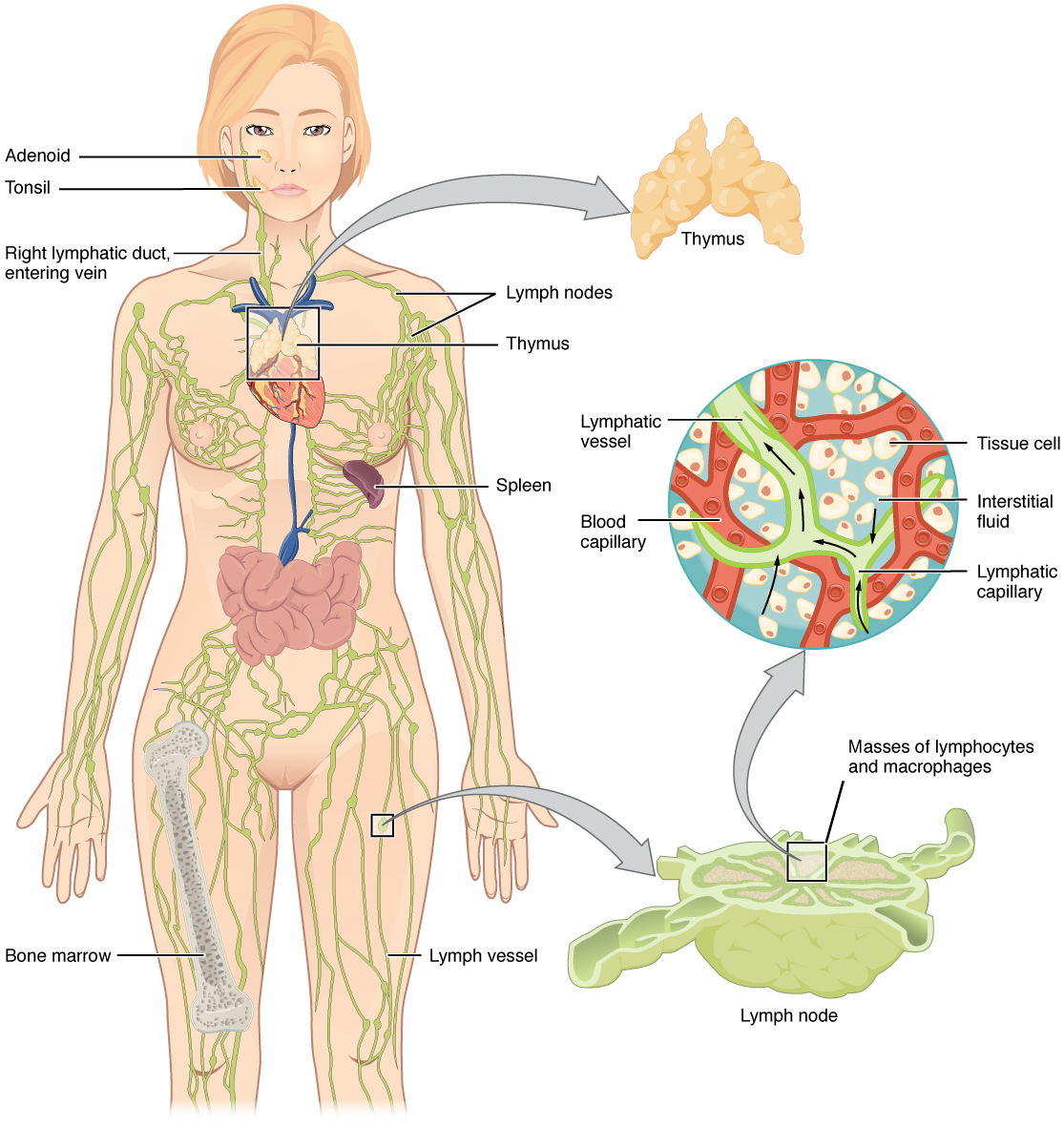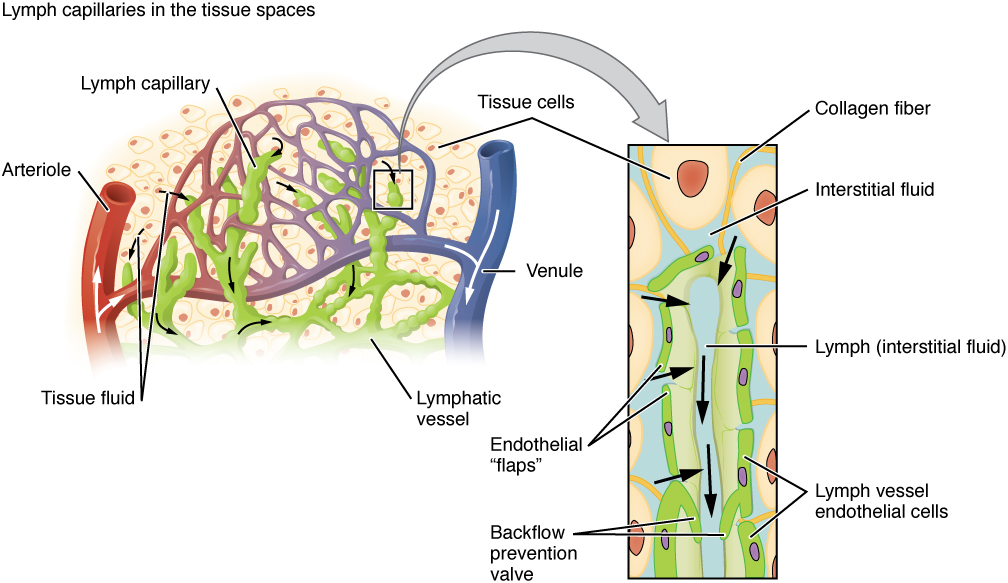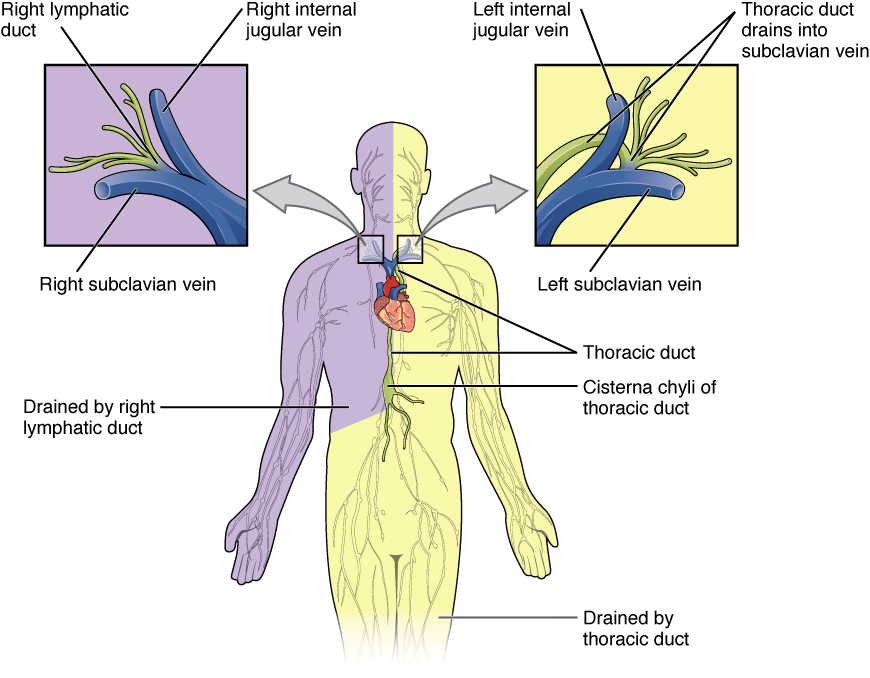The Lymphatic System
Objective 6
Describe the structure and primary functions of the lymphatic system. Compare plasma, interstitial fluid and lymphatic fluid. Explain how lymphatic fluid is formed, how it circulates and where it joins the circulatory system.
The lymphatic system is a system that runs throughout the body and is made up of lymphatic vessels and supporting organs that drain excess interstitial fluid, transport dietary lipids, and facilitate immune responses.

The lymphatic system includes: lymphatic fluid (lymph), lymphatic capillaries, vessels, trunks, ducts, lymph nodes and nodules, red bone marrow, the thymus gland, and the spleen.
Lymphatic vessels are different from blood vessels. Blood vessels contain blood that circulates to and from the heart. The lymphatic vessels carry lymphatic fluid (lymph) one way: from the tissue back into the blood stream.
Lymph vessels originate as small lymphatic capillaries that are located throughout the body in the interstitial spaces. Lymphatic capillaries have overlapping endothelium that allows interstitial fluid into but not out of the capillaries. If pressure in the interstitial space is high, fluid flows into the lymphatic capillaries; if it is low, the flaps close and fluid doesn’t enter. The lymphatic capillaries are held in place by anchoring filaments. These are specialized fibers arising from the capillaries that extend into the tissue.

As lymphatic capillaries converge, they form larger lymphatic vessels. Lymphatic vessels have thin walls and valves to encourage one-way fluid movements.
Lymph nodes are present at intervals along the lymphatic vessels. The lymph nodes provide an opportunity for cells of the immune system to come in contact with lymphatic fluid. It is like a specialized sampling process. The immune system gets a continuous flow of information about what is taking place in the body by draining and monitoring lymphatic fluid.
Plasma is filtered by the capillary walls to form interstitial fluid. Most of the interstitial fluid is reabsorbed back into the blood stream. Any excess fluid is drained from the tissue through the lymphatic capillaries. On an average day, 20 liters of fluid passes from the blood into the interstitial space; 17 liters are reabsorbed back into the capillaries. The lymphatic vessels drain the remaining three liters.
 Because proteins are too large to easily pass through the capillary walls, the plasma contains a much higher amount of protein than interstitial fluid and lymph. Lymphatic fluid is essentially just drainage from the tissue, so it is identical to interstitial fluid, with one small exception. The lymphatic system plays a role in transporting absorbed dietary lipids from the GI tract, so lymphatic fluid would have a higher quantity of lipids than interstitial fluid.
Because proteins are too large to easily pass through the capillary walls, the plasma contains a much higher amount of protein than interstitial fluid and lymph. Lymphatic fluid is essentially just drainage from the tissue, so it is identical to interstitial fluid, with one small exception. The lymphatic system plays a role in transporting absorbed dietary lipids from the GI tract, so lymphatic fluid would have a higher quantity of lipids than interstitial fluid.

Two mechanisms assist with the flow of lymphatic fluid. Skeletal muscle contraction “milks” the lymphatic vessels and encourages lymph movement. Respiratory movements encourage lymph flow by increasing and decreasing thoracic and abdominal pressures. In both scenarios, the valves present in the lymphatic vessels restrict back-flow of lymph, forcing it to circulate in one direction. Lymphatic fluid circulates through the system of vessels, eventually making it to the subclavian veins where it joins the circulatory system at the right and left lymphatic ducts. The duct on the left side, also known as the thoracic duct, is significantly larger than the one on the right and drains about 75% of the lymphatic fluid from the body. The right lymphatic duct drains lymphatic fluid only from the upper right portion of the body.
Media Attributions
- U15-032 Anatomy of the Lymphatic System © Betts, J. Gordon; Young, Kelly A.; Wise, James A.; Johnson, Eddie; Poe, Brandon; Kruse, Dean H. Korol, Oksana; Johnson, Jody E.; Womble, Mark & DeSaix, Peter is licensed under a CC BY (Attribution) license
- U15-033 Lymphatic Capillaries © Betts, J. Gordon; Young, Kelly A.; Wise, James A.; Johnson, Eddie; Poe, Brandon; Kruse, Dean H. Korol, Oksana; Johnson, Jody E.; Womble, Mark & DeSaix, Peter is licensed under a CC BY (Attribution) license
- U15-034 Interstitial vs Lymphatic Fluid Textbox © Price, Travis and Newton, Kathy is licensed under a CC BY-SA (Attribution ShareAlike) license
- U15-035 Major Trunks and Thoracic Ducts © Betts, J. Gordon; Young, Kelly A.; Wise, James A.; Johnson, Eddie; Poe, Brandon; Kruse, Dean H. Korol, Oksana; Johnson, Jody E.; Womble, Mark & DeSaix, Peter is licensed under a CC BY (Attribution) license

